
A globular cluster is a spheroidal conglomeration of stars that is bound together by gravity, with a higher concentration of stars towards their centers. They can contain anywhere from tens of thousands to many millions of member stars, all orbiting in a stable, compact formation. Globular clusters are similar in form to dwarf spheroidal galaxies, and the distinction between the two is not always clear. Their name is derived from Latin globulus. Globular clusters are occasionally known simply as "globulars".

The Sagittarius Dwarf Spheroidal Galaxy (Sgr dSph), also known as the Sagittarius Dwarf Elliptical Galaxy, is an elliptical loop-shaped satellite galaxy of the Milky Way. It contains four globular clusters in its main body, with the brightest of them—NGC 6715 (M54)—being known well before the discovery of the galaxy itself in 1994. Sgr dSph is roughly 10,000 light-years in diameter, and is currently about 70,000 light-years from Earth, travelling in a polar orbit at a distance of about 50,000 light-years from the core of the Milky Way. In its looping, spiraling path, it has passed through the plane of the Milky Way several times in the past. In 2018 the Gaia project of the European Space Agency showed that Sgr dSph had caused perturbations in a set of stars near the Milky Way's core, causing unexpected rippling movements of the stars triggered when it moved past the Milky Way between 300 and 900 million years ago.
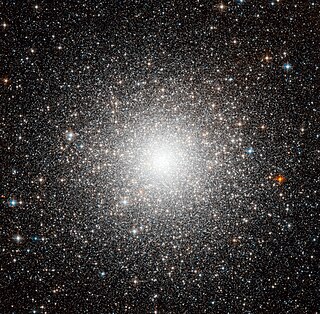
Messier 54 is a globular cluster in the constellation Sagittarius. It was discovered by Charles Messier in 1778 and then included in his catalog of comet-like objects.

A dwarf galaxy is a small galaxy composed of about 1000 up to several billion stars, as compared to the Milky Way's 200–400 billion stars. The Large Magellanic Cloud, which closely orbits the Milky Way and contains over 30 billion stars, is sometimes classified as a dwarf galaxy; others consider it a full-fledged galaxy. Dwarf galaxies' formation and activity are thought to be heavily influenced by interactions with larger galaxies. Astronomers identify numerous types of dwarf galaxies, based on their shape and composition.
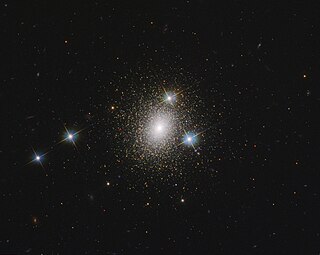
Mayall II, also known as NGC-224-G1, SKHB 1, GSC 2788:2139, HBK 0-1, M31GC J003247+393440 or Andromeda's Cluster, is a globular cluster orbiting M31, the Andromeda Galaxy.

A dwarf spheroidal galaxy (dSph) is a term in astronomy applied to small, low-luminosity galaxies with very little dust and an older stellar population. They are found in the Local Group as companions to the Milky Way and as systems that are companions to the Andromeda Galaxy (M31). While similar to dwarf elliptical galaxies in appearance and properties such as little to no gas or dust or recent star formation, they are approximately spheroidal in shape and generally have lower luminosity.
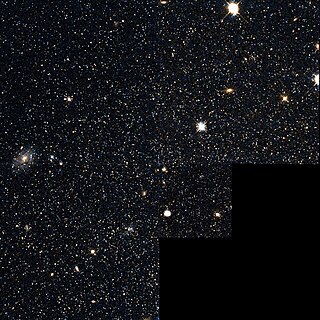
Andromeda I is a dwarf spheroidal galaxy (dSph) about 2.40 million light-years away in the constellation Andromeda. Andromeda I is part of the local group of galaxies and a satellite galaxy of the Andromeda Galaxy (M31). It is roughly 3.5 degrees south and slightly east of M31. As of 2005, it is the closest known dSph companion to M31 at an estimated projected distance of ~40 kpc or ~150,000 light-years.
Ursa Major I Dwarf is a dwarf spheroidal galaxy that orbits the Milky Way galaxy. It was discovered in 2005 within the Ursa Major constellation and is the third least luminous known galaxy.
Ursa Major Dwarf is a name for two dwarf spheroidal galaxies orbiting the Milky Way Galaxy.
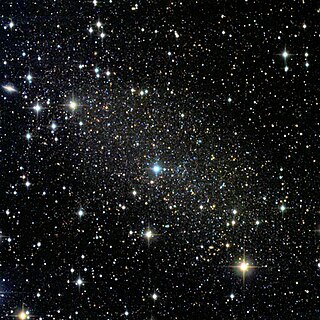
The Ursa Minor Dwarf is a dwarf spheroidal galaxy, discovered by A.G. Wilson of the Lowell Observatory, in the United States, during the Palomar Sky Survey in 1955. It appears in the Ursa Minor constellation, and is a satellite galaxy of the Milky Way. The galaxy consists mainly of older stars and seems to house little to no ongoing star formation. Its centre is around 225,000 light years distant from Earth.

The Fornax Dwarf Spheroidal is an elliptical dwarf galaxy in the constellation Fornax that was discovered in 1938 by Harlow Shapley. He discovered it while he was in South Africa on photographic plates taken by the 24 inch (61 cm) Bruce refractor at Boyden Observatory, shortly after he discovered the Sculptor Dwarf Galaxy.

Palomar 12 is a globular cluster in the constellation Capricornus, and is a member of the Palomar Globular Clusters group.

Palomar 5 is a globular cluster and a member of the Palomar Globular Clusters group. It was discovered by Walter Baade in 1950, and independently found again by Albert George Wilson in 1955. After the initial name of Serpens, it was subsequently catalogued as Palomar 5.

Palomar 1 is a globular cluster part of the Palomar group in the constellation Cepheus in the halo possibly in the Outer Arm of the Milky Way galaxy. First discovered by George O. Abell in 1954 on the Palomar Survey Sky plates, it was catalogued as a globular cluster. At 6.3 to 8 Gyr, it is a very young cluster when compared to the other globular clusters in the Milky Way. It is a relatively metal-poor globular with [Fe/H] = −0.60. It is likely that Palomar 1 has a similar evolutionary history to the Sagittarius dwarf companion globular Terzan 7, that is, it may have once been associated with a dwarf spheroidal galaxy that was later destroyed by tidal forces.

Terzan 7 is a sparse and young globular cluster that is believed to have originated in the Sagittarius Dwarf Spheroidal Galaxy and is physically associated with it. It is relatively metal rich with [Fe/H] = -0.6 and an estimated age of 7.5 Gyr. Terzan 7 has low levels of nickel which supports its membership in the Sag DEG system since it has a similar chemical signature. It has a rich population of blue stragglers that are strongly concentrated toward the center of Terzan 7. It has an average luminosity distribution of Mv = -5.05. It has a half-light radius (Rh) of 6.5pc.

Palomar 6 is a loose globular cluster in the constellation Ophiuchus that belongs to the Milky Way galaxy. It is a member of the Palomar Globular Clusters group. It is located about 25,000 light-years away from the Sun. It formed in what would become the bulge of the Milky Way. It is similar to other old-bulge globular clusters such as Messier 62, NGC 6522, NGC 6558, and Haute-Provence 1.

NGC 7492 is a globular cluster in the constellation Aquarius. It was discovered by the astronomer William Herschel on September 20, 1786. It resides in the outskirts of the Milky Way, about 80,000 light-years away, more than twice the distance between the Sun and the center of the galaxy, and is a benchmark member of the outer galactic halo. The cluster is immersed in, but does not kinematically belong to, the Sagittarius Stream.
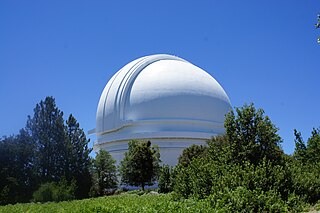
The Palomar globular clusters are some of the faintest of all globular clusters in the Milky Way galaxy, and been discovered in the 1950s on the survey plates of the first Palomar Observatory Sky Survey (POSS). In total there are 15 Palomar globular clusters, which include Palomar 1, Palomar 2, Palomar 3, Palomar 4, Palomar 5, Palomar 6, Palomar 7, Palomar 8, Palomar 9, Palomar 10, Palomar 11, Palomar 12, Palomar 13, Palomar 14, and Palomar 15. Some Palomar Globulars, like Palomar 6, Palomar 7, Palomar 9, Palomar 10 and Palomar 11 are clusters of average size located nearby, yet obscured in our line of sight by dust. Other Palomar globulars, like Palomar 3, Palomar 4 and Palomar 14 are giants located in the far outer halo of the Milky Way. Some even originated from a different galaxy, such as Palomar 12 from the Sagittarius Dwarf Spheroidal Galaxy, which is now known as a satellite of the Milky Way. Observation of different Palomar globulars greatly varies in the degree of difficulty depending on the cluster. Some are small and compact, others are very sparse, to the point where they may be hard to distinguish from foreground stars.

















